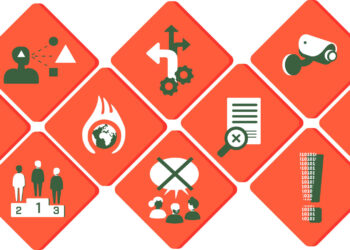In my September post, I announced the Mental Health Task Force and the development of several strategic initiatives to support mental health awareness for SSP members. The response from that article and the support that it generated was a profound affirmation that we are a Society that values the glimmer in one another and that we shine brighter through our connections. The Task Force will remain active throughout the remainder of my term as SSP President, and we will be inviting members to contribute to working groups that advance the objectives of those initiatives.
One of these working groups is focused on publishing more information and perspectives on mental health issues here in The Scholarly Kitchen. I’m happy to say that today marks the beginning of Mental Health Awareness Mondays — a series of posts published each Monday throughout November that share valuable resources, guidance and information, and deeply personal experiences and perspectives on mental health issues. The contributions reflect a diverse representation of voices from across the SSP membership, including mid-career professionals, students, senior leadership, and organizational members. That diversity of perspectives personifies our Core Values and illustrates the various ways in which mental health challenges can touch each of our lives.
For me, it was important to deliver Mental Health Awareness Mondays in November.
Seasonal affective disorder (SAD) often starts in autumn and continues into and throughout the winter months. According to the National Alliance on Mental Illness (NAMI), 64% of people living with a mental illness felt that their conditions grew worse around the holidays. An American Psychological Association survey reported that 38% of people felt their stress levels increased during the holiday season. Additionally, the Monday blues, distress caused by the conclusion of the weekend and return to routine, can lead to clinical conditions that include anxiety, stress, and depression. Each of these factors, weighed individually or collectively, further substantiates the significance and potential of our Mental Health Awareness Monday posts, which we plan to continue on a monthly basis in 2024. I hope that you’ll share them with your colleagues, HR departments, and leadership, and that they inspire respectful conversations around mental health awareness.
Award-winning actress Glenn Close said “What mental health needs is more sunlight, more candor, and more unashamed conversation.” We will continue featuring mental health-related posts in The Scholarly Kitchen each month. If you are interested in submitting a guest post, please contact scholarlykitchen@sspnet.org. We’re also looking at ways to enable anonymous contributions, and will share information about that process once it’s available.
Today’s post, from the American Psychiatric Association (APA), was championed by industry leader Simone Taylor. Simone contacted me shortly after the September post and we had several engaging conversations exploring the possible ways that the APA, a trusted SSP member organization and global leader operating in this space, could be involved. I’m sure you’ll find these tips for publishers from Emma Jellen, Interim Director of their Center for Workplace Mental Health, a good starting point for thinking about how you and your organization can better support mental wellness.
Mindset Matters: Tips for Publishers from the Center for Workplace Mental Health
Publishing is a changing industry, and with that change comes stress. The workplace is a common source of stress across sectors and industries, which is why the American Psychiatric Association Foundation supports mental wellness in the workplace through the Center for Workplace Mental Health. The Center provides employers from publishing and other industries with tools and information to promote the mental health of employees and their families. Find out more in this Q&A with Emma Jellen, Interim Director of the Center.
Q: What can employers do to help employees manage their mental health?
A: Mental wellness is easier to achieve in the workplace when leaders model healthy boundaries, like setting reasonable work hours and taking breaks during the workday. Another key is to make mental wellness a part of workplace culture by talking about it openly. Ensure that your benefits will help your employees succeed; offer Employee Assistance Programs and robust health insurance.
Q: Publishers juggle many different priorities. In that context, why is it important to have a workplace mental health initiative?
A: From textbook publishers to magazine publishers, many employees are not getting the support they need to perform well. Addressing employee mental health not only benefits them and their families, but also affects an organization’s bottom line. The return on investment for investing in employee mental health is broad: you are likely to see increases in productivity and presenteeism, recruit more staff, and retain them for longer.
COVID-19 affected all of us, and many of us are still feeling the effects of isolation from our friends and family. Managers became responsible for checking on their direct reports, and we became more open about our mental health during and after the pandemic. On the flip side, employers realized that they have a critical role to play in employee well-being beyond offering voluntary activities like yoga, which may not always permanently resolve the problems. Employers understand now that they have a responsibility to facilitate access to mental health services and support for staff.
Q: I am a people manager at my publishing organization. What can I do to support the mental health of my direct report(s)?
A: People managers are often poised to notice changes in a direct report’s behavior that warrant checking in with them. Asking if someone is okay is not always easy, but it is important. Choose a time and space with limited distractions, then share objective observations such as “I’ve noticed you’ve recently missed deadlines, and that’s not like you. I’m concerned about you and want to check in.” Lead with empathy and focus on listening, not offering solutions. Finally, connect the person to services and support (such as an EAP) and make sure to follow up on the conversation after a few days have passed.
Q: What makes for a successful workplace mental health initiative?
A: Most successful workplace mental health programs or initiatives that we see come from organizations that follow these four principles:
- Secure Leadership Support: Use leadership speeches and presentations to start a dialogue about mental health and, if possible, share personal stories that reinforce that “everyone knows someone” who is struggling with their mental wellness
- Get Employees Involved: Form and strengthen an Employee Resource Group (ERG) focused on mental health. ERGs not only provide a greater sense of community for staff, but they also demonstrate an organizational commitment to employee well-being
- Communicate Often: Your workplace mental health initiative should be highly visible. Use all available communications vehicles to send the message that employee mental health is an organizational priority
- Measure the Impact: Start the planning process by deciding what success will look like for your organization. For example, you might measure your progress in employee performance, employee productivity, employee retention, short- and long-term disability claims, Employee Assistance Program (EAP) usage, or other metrics
Q: What resources are available to help support better workplace mental health?
A: The Center’s website, workplacementalhealth.org, includes a wealth of resources, from educational videos to case studies and toolkits. Visit the site to learn how to support family caregivers in the workplace, how to choose the right EAP model for your organization, how to recognize the symptoms of burnout, and much more.
Discussion
1 Thought on "Introducing Mental Health Awareness Mondays: Tips for Publishers from the Center for Workplace Mental Health"
“Reasons for the Season” can have a lot of meanings at the end of the year/start of new year. Pressures, aspirations, reflections, losses and expectations… and that is without the trauma of wars. This is the time to be gentle and kind and assume nothing is as it appears….




